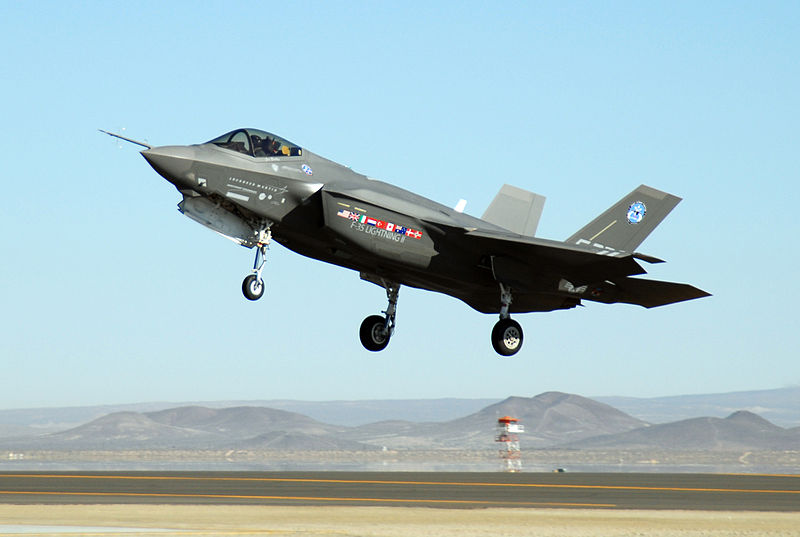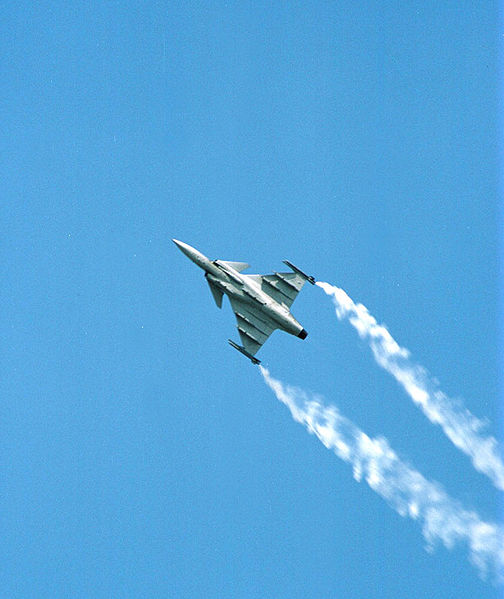

Leaked US diplomatic cables reveal a concerted, multi-departmental American lobbying effort in 2008 to convince Norwegian policymakers to purchase F-35 fighter jets instead of a Swedish-made rival for fear rejecting the stealth aircraft could influence other countries.
The campaign was designed to talk up the F-35's capabilities in public while applying "forceful" pressure on Norwegian officials in private. At the same time, there was an apparent effort to influence the Norwegian decision by withholding a key component for the Swedish aircraft.
The revelations could resurrect questions about the role the US government played in Canada's decision to purchase the same planes, which has already been the subject of intense debate.
In 2008, the Norwegian government was looking to replace its aging fleet of F-16 fighters, and was trying to decide between US-based Lockheed Martin's new F-35 Joint Strike Fighter, or JSF, and Saab's Gripen fighter aircraft.
A decision was due to be announced on Dec. 18, 2008, and in the final few months, with Saab undertaking an aggressive campaign based on stronger industrial benefits to Norway, the tide was turning towards the Gripen.
"Saab's promotion of its industrial package was intensive and covered every province of Norway," reads a cable from the US Embassy in Oslo and leaked through Wikileaks. "Norwegian Labor Party leaders admitted to Embassy that they received frequent calls from local mayors in favor of the Gripen."
US embassy officials also reported a "seemingly well-orchestrated public campaign against the F-35's abilities and attacks on US interventionist foreign policy which an F-35 purchase by implication supports. Very senior contacts, including the President of the Parliament, are said to believe that the GON is likely to choose the Gripen, based largely on political reasons."
The cables noted that whichever decision Norway made, it would be the largest purchase the country had ever made.
The US envoys wrote that, for a variety of reasons, the Norwegian government's decision "is of more importance than it may appear on the surface."
"The first reason is for the JSF program," reads one cable. "A decision by one of the original partners to purchase a competitor would be damaging. In addition, the timing of the [Norwegian] decision comes before the Danish and Dutch decisions on the F-35. While Norway's decision will not determine the Danish or Dutch decision, a Norwegian decision to buy Gripen could have an impact."
In addition, US officials were worried that purchasing the Gripen would weaken Norway's ability to defend NATO's northern flank at a time of increased Russian military activity, hurt NATO interoperability, "significantly alter the forty-year close relationship between our Air Forces and weaken one of the strongest pillars of our bilateral relationship."
On Sept. 22, US diplomats in Oslo requested "senior-level advocacy for the F-35" that would stress the plane's abilities, counter misinformation being reported in the media, and also help the Norwegian government "recognize the seriousness of their decision and resist the temptation of making a short-term expedient choice, but damaging long-term interests."
Playing the waiting game
Three months earlier, on June 25, 2008, US ambassador to Sweden Michael Wood met with Swedish Defence Minister Sten Tolgfors to discuss using a US-made radar in the Saab Gripen. According to a cable from the US Embassy in Stockholm, including the AESA radar in the Swedish-made plane "would enhance Nordic region air coverage and [NATO] interoperability."
"The Gripen contains 50 percent US content, including engines, avionics and weapon systems," adds the cable dated July 9, 2008 and penned by Mr. Wood. "Sales of the Gripen are good for US industry. AESA would increase US content and enhance sales prospects."
However, Mr. Wood recommended the US postpone responding to the Swedish request, "taking into account the potential impact on the Norway fighter jet competition." He noted that Norway was scheduled to make a decision on the JSF or Gripen that December, and that Denmark, would be following suit shortly thereafter.
"Given this potential impact of AESA releaseability on the Norway competition, and possibly the Denmark competition," reads the cable, "we suggest postponing the decision on AESA releaseability for the Gripen until after Norway's decision in December."
Aware this would upset the Swedes, Mr. Wood recommended "doing something else for Sweden to demonstrate our bilateral engagement and support for Nordic co-operation, while informing them of the delay."
The cable did not say whether the recommendation was acted upon.
The tide turns
The Canadian debate over whether to buy the F-35 has centred on whether it is the best plane to meet Canada's needs at the best price. Those in favour say it is, while those opposed say the government's decision was, in part, made to appease the US, which has placed a great deal on the line with the project.
Following the Oslo Embassy's request for high-level advocacy, State and Defence Department officials undertook what was variously described in one cable as a "committed effort," a "dedicated USG [US Government] effort" and "strong engagement." This included meetings, phone calls and an outreach campaign that "delivered a strong, co-ordinated USG message which publicly professed the unequalled capabilities of the aircraft and the value we place on the relationship, and privately pressed for the selection of the F-35."
Then-deputy defense minister Espen Barth Eide—at the time considered the real power in the Norwegian Defence Ministry, according to another US cable—reportedly sad that "a swing to the Gripen was not possible once the qualitative difference between the planes became clear."
Yet interestingly, one line in another cable, then-defence minister Anne-Grete Strom-Erichsen told the US ambassador that "the process is set and only [the Ministry of Defence] knows the full data on the planes. She urged the Ambassador to be reassured about the process." It was unclear what this meant.
Meanwhile, US diplomats recognized the sensitivities that would arise if they appeared to be pressuring the Norwegians into buying the aircraft, writing that "deciding our line on this was critical."
"We needed to avoid any appearance of undue pressuring (which was construed as 'threatening' Norway in its sovereign decision-making process), but we couldn't let stand the view that the choice didn't matter for the relationship," reads a "Lessons Learned" cable written after the F-35 was selected. "We opted for 'choosing the JSF will maximize the relationship' as our main public line. In private, we were much more forceful."
As a result of the effort, the embassy reported that "the tide has turned in Norway." "The media have recently run a number of articles from active duty and retired officers extolling the strengths of the F-35. Commentators who have previously said the Gripen is the best plane have been attacked by leading Parliamentarians for being ill-informed."
On Nov. 20, 2008, Norwegian Prime Minister Jens Stoltenberg and then-defence minister Anne-Grete Strom-Erichsen announced that the government was going with the F-35. The timing of the announcement and veracity with which the US-built plane was endorsed by the two Norwegian leaders surprised embassy officials
In reporting the Norwegian decision on Nov. 25, 2008, US officials in Oslo gave full credit to the high-level interdiction, saying that "strong and consistent engagement by senior defense and state officials played a key role in persistently lobbying without overplaying our hand
http://www.embassymag.ca/page/view/jsf-12-08-2010
المقال طويل ولكنى ساختصر الترجمه
لفهم السبب الذى دفع النرويج لإختيار الأف35 وصرف النظر عن الجريبيين
وهذا ما كشفته وثائق ويكيليكس المسربه
وتعالوا معآ نعرف كيفية تعامل الأمريكان والضرب تحت الحزام حتى مع أقرب حلفائهم
من المعروف أن النرويج تنوى إحلال إسطولها من مقاتلات الأف16 القديمه بمقاتلات جديده
واعربت عن ذلك فى عام 2008
وتم تقديم عرضين للنرويج
عرض من أمريكا بالأف35
وعرض من السويد بالجريبين
وقامت امريكا وقتها بالضغط على النرويج لشراء الأف35
بحجة ان النرويج تابعه لحلف الناتو وهى فى مواجهة روسيا وتحتاج طائره أكثر تقدمآ من الجريبين
إنما الحقيقه إن أمريكا كانت تخشى أنه لو قامت النرويج بشراء الجريبين
فستحذو باقى الدول الإسكندفانيه حذوها
وتخسر أمريكا هذه الصفقات
فقامت بالضغط لأبعد درجه
على الجانب الأخر
قامت شركة ساب السويديه بحمله شامله فى كل أرجاء النرويج للترويج للجريبين
حتى أن رؤساء البلديات المحليه دعمو الجريبين
فقام مسئؤلين بالسفاره الأمريكيه بالنرويج بكتابة تقارير لواشنطن أن الحكومه والبرلمان فى النرويج يتوجهان إلى الجريبين
ومدى تأثير ذلك على الأف35
وحذر المسئؤلين فى السفاره
من خطورة هذا القرار
وتأثيرها على الدنمارك وهولندا وهذان البلدان كانا فى مفاوضات لشراء الأف35
وسيكون التأثير مدمرآ على حظوظ الأف35
كما حذر المسئؤلين
من ان الجريبين لن تستطيع الدفاع عن الأجواء الشماليه للناتو فى مواجهة روسيا
فى شهر سبتمبر 2008
ضغطت أمريكا على النرويج ونصحتها بعدم التسريع بإتخاذ قرار قد يؤثر على علاقتهما طويلة الأمد
وقامت بعرض مميزات الأف35 عليها
فى الناحيه الأخرى
كان هناك إجتماع فى السويد بين السفير الأمريكى
و وزير الدفاع السويدى لبحث تزويد الولايات المتحده لمقاتلة الجريبين برادار aesa
ومن المعروف أن الجريبين
يوجد بها 50 بالمائه مكونات أمريكية الصنع من محرك وإلكترونيات
فى الوثيقه التى أرسلها السفير الأمريكى بالسويد إلى وزارة الخارجيه الأمريكيه
قال فيها أنه مما لا شك فيه أن الجريبين تدعم الصناعه والصادارت الأمريكيه
ولكنه أوصى بتأجيل طلب السويد بتزويدها برادار aesa
لكى يؤثر على الجريبين فى المنافسه مع الأف35
بالنسبه لصفقة النرويج
وخاصة أن صفقة الدنمارك ستتبع الصفقه النرويجيه وتليها الهولنديه
وقال السفير الأمريكى
يجب أن نقوم بالتأخير
وإظهار إننا متعاونون مع السويد ومحافظين على هذا التعاون لعدم ذهاب السويد إلى مصدر أخر
بعد ذلك ظهر الفرق
بين الجريبين والأف35 أمام النرويج
وان الجريبين لن تلبى متطلبات النرويج
فتغير موقف النرويج
وبالفعل تحذو هولندا والدنمارك حذو النرويج الأن
